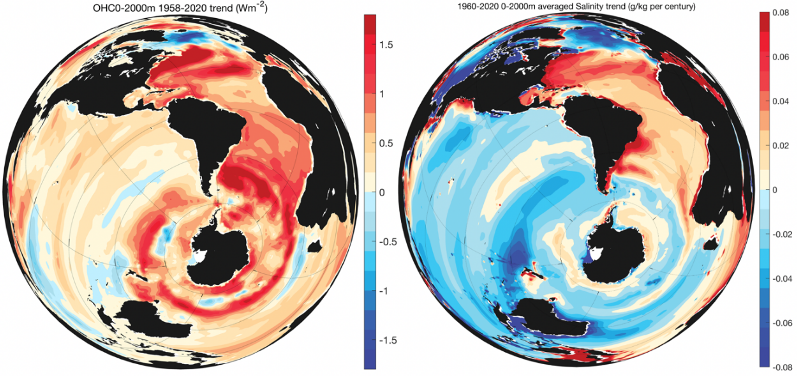
Observed upper 2000 m ocean heat content and ocean salinity trends in the past half century. Image Credit: Data from IAP ocean dataset. (http://www.ocean.iap.ac.cn/).
This implies slow rising changes like deep ocean warming and the sea-level increase will remain for a long time afterward.
Climate scientists, in a new review study, debate that this implies climate actions need to be fixed at several time scales. The study has been recently reported in the journal Atmospheric and Oceanic Science Letters.
In the short term (by approximately 2030), goals like the United Nations Sustainable Development Goals (SDGs) will be crucial. Over prolonged times (~2050–2060 and beyond), global carbon neutrality targets may be met as countries keep working toward decreasing emissions.
There is a need for climate actions to extend further beyond the present period of focus to time scales of hundreds of years. On such time scales, making for “high impact, low probability” risks—like a sudden irreversible ice sheet loss and deceleration of Atlantic Ocean circulation—must be completely combined into planning for the long term.
The global ocean, spanning 70% of the Earth’s surface, absorbs and discharges heat a lot slower compared to the land. Also, the huge mass and heat capacity implies that the ocean is more capable of storing heat than land or air, and thus the ocean is considered the most significant controlling component of the Earth’s climate.
This “ocean thermal inertia” provides both good news and bad news concerning climate change. It implies that the planet is not heating up as quickly as it would in the absence of an ocean.
However, it implies that even if greenhouse gas emissions are halted by around 2050 to 2060, as set out in the United Nations Paris Agreement—like a hastening train that takes time to decelerate as soon as the brakes are hit—the climate system will still continue to change for a significant amount of time later on.
The ocean will continue to warm as heat is transported in the downward direction into deeper ocean waters. Also, the climate system will only re-stabilize when that deep ocean stops warming and the Earth reaches an equilibrium between incoming and outgoing heat.
"This process means that while surface warming may stabilize at about 1.5–2 ℃ when global emissions reach net-zero emissions, sub-surface ocean warming will continue for at least hundreds of years, yet we normally only talk about climate action on the scale of a few decades to the end of the century at the most. That needs to change."
John Abraham, Study Lead Author, Professor and Researcher, Mechanical Engineering, University of St. Thomas in Minnesota
Accordingly, a system of scientific ocean tracking with that time scale in mind must be developed. In addition, to sea level and subsurface temperature, the tracking of ocean climate trends like sea ice, pH, ocean surface heat flux, carbon, salinity, and currents, will need long-lasting consistent, and calibrated measurements.
Also, in comparison with the temperature, such essential climate variables are currently much less observed.
"Changes to the ocean will also continue to impact extreme weather over these longer periods, as well as sea-level rise. And infiltration of sea water into fresh water supplies can affect coastal food supplies, aquifers, and local economies."
Lijing Cheng, Professor, Ocean and Climate Scientist, Institute of Atmospheric Physics, Chinese Academy of Sciences
Cheng added, “Other impacts that are connected to ocean warming and so need to be considered for the very long term include more damaging storm surges, coastal erosion, marine heatwaves, ocean acidification, and marine oxygen depletion.”
“Clearly this later group of measures will take a much longer time to implement but will also provide much longer-lasting benefits. Multi-scale adaptation practices like this should be considered throughout the globe,” stated Michael E Mann, Study Co-Author and Climatologist, Pennsylvania State University
Eventually, societies need to start ensuring that they are resilient in the face of “high impact, low probability” events (an unlikely event that would have major consequences), such as an abrupt showdown of Atlantic Meridional Overturning Circulation, large methane emissions from the seabed or thawing permafrost, passing a tipping point for losing a major ice sheet, or an abrupt shift and transition of ocean ecosystem including a major extinction event.
The scientists hope to communicate with key decision-makers, city planners, and vulnerable communities in the future to ensure that their conclusions are based on sound climate and ocean science.